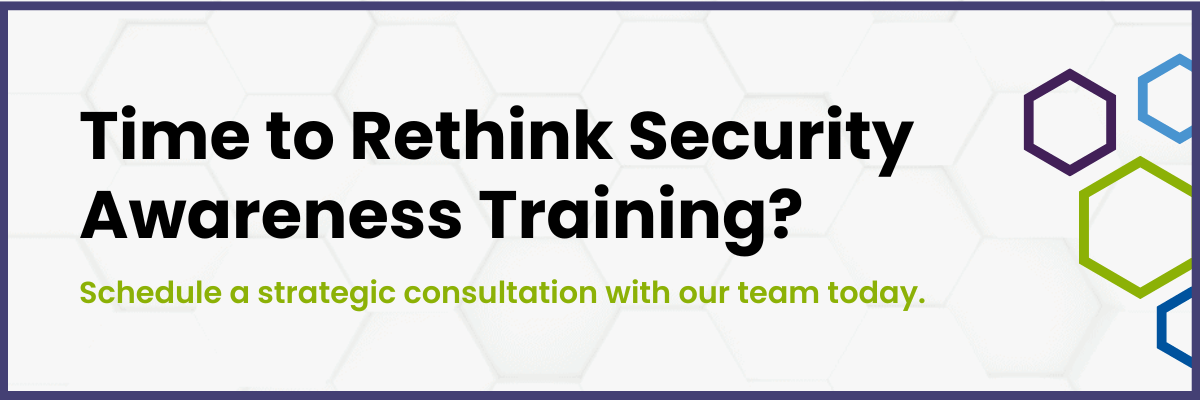When a cybersecurity incident occurs, what’s the first question leadership asks? Too often, it’s “Who clicked on what?” This knee-jerk reaction to find someone to blame might feel natural, but it’s actually undermining your organization’s security posture and making future incidents more likely.
Modern businesses face an uncomfortable truth: traditional security awareness training isn’t working as intended. Despite millions invested in training programs, phishing simulations, and security policies, human-related risk still plays a major role in cyber incidents.
The problem isn’t that employees are inherently careless or that training content is inadequate. The issue lies in how organizations approach the human element of cybersecurity more broadly.
Blame Culture Breeds Cybersecurity Vulnerabilities
Recent studies reveal a troubling trend. One 2025 survey, conducted in Ireland by IT.ie and SonicWall, found that 73% of office workers believed their employers held staff personally responsible for cybersecurity incidents.
This blame culture creates an environment where employees are reluctant to report potential security issues, leaving organizations vulnerable to undetected threats. When workers fear punishment for honest mistakes, they’re more likely to hide problems that could escalate into major breaches.
The Human Factor Remains Critical in Cybersecurity…
Humans will always be part of the cybersecurity equation. Instead of treating employees as the weakest link, successful organizations recognize them as their first line of defense. This shift in perspective transforms security from a purely technical challenge to a people-centered strategy that acknowledges human nature rather than fighting against it.
…So Why Do Traditional Approaches to Security Awareness Training Fall Short?
The reality is that cyber incidents are becoming increasingly sophisticated. Phishing emails now mimic legitimate communications with startling accuracy, and social engineering attacks exploit natural human behaviors like helpfulness and trust.
Expecting employees to be perfect gatekeepers against professional criminals – when the extent of their cybersecurity awareness is once-a-year, seminar-style training based on best practices from 2015 – is unrealistic and unfair.
Practical Steps for Better Training
Effective security awareness training incorporates several proven strategies. First, it’s ongoing rather than annual. Regular, brief training sessions maintain awareness without causing training fatigue. Second, it’s relevant to employees’ actual work experiences, using examples and scenarios they’re likely to encounter.
Measure What Matters
Third, successful programs measure the right metrics. Instead of focusing solely on click rates in phishing simulations, they track positive behaviors like security incident reporting, password manager adoption, and overall security awareness survey results.
Clear, Actionable Guidance
The awareness training should also provide practical and specific guidance. Telling employees to “be careful” with email isn’t helpful. Teaching them to “verify unusual requests through alternative communication channels” is.
Moving Beyond Fear-Based Training Takes a Shift in Mindset
Traditional security training can sometimes rely on scare tactics and punishment, creating anxiety around cyber incidents without building genuine competence – a bit like the early days of D.A.R.E.
This approach backfires by making employees afraid to engage with security protocols or report suspicious activity. Fear-based training may temporarily change behavior, but it doesn’t create lasting security awareness.
Think “Empowerment” Over “Punishment”
In 2025, cybersecurity awareness training should focus less on punishing people for making the wrong choices and more on empowering them to make the right ones. It needs to provide employees with practical tools and knowledge they need to make good decisions while creating psychological safety for reporting potential issues, too.
Adopt a Skills-Based Learning Approach
Modern security awareness training also treats cybersecurity as a skill set that can be developed through practice, just like any other professional competency. This method includes regular, bite-sized training sessions that fit into busy schedules rather than overwhelming annual sessions that employees quickly forget.
Are Your Phishing Simulations Building Skills or Breeding Distrust?
Phishing simulations have become a popular component of security awareness training for good reason, but their implementation matters enormously. When used as “gotcha” moments to catch and shame employees, these exercises damage trust and create resentment.
However, when positioned as learning opportunities with immediate, constructive feedback, they can be incredibly valuable.
When It Comes to Security Awareness Training, Practice Makes Perfect
The key is treating simulations as practice sessions rather than tests. Just as pilots use flight simulators to safely practice emergency procedures, employees can use phishing simulations to develop their detection skills in a safe environment that doesn’t pose a threat to your business.
Beyond Security Awareness Training: Building Cultural Buy-In
Cybersecurity training succeeds when it becomes part of organizational culture rather than an imposed box-checking exercise. This cultural shift requires leadership commitment and consistent messaging that positions cybersecurity as everyone’s responsibility, not just the IT department’s.
Characteristics of Strong Security Cultures
Organizations with strong security cultures share certain characteristics:
- They celebrate employees who report suspicious activity, even if it turns out to be a false alarm.
- They provide clear, accessible channels for reporting concerns without fear of retribution.
- Most importantly, they treat security mistakes as learning opportunities rather than disciplinary issues.
The Business Case for Change
Organizations that move beyond blame-the-user approaches see measurable improvements in their security posture. Employees become more engaged in security initiatives, incident reporting increases, and the overall culture becomes more resilient against social engineering attacks.
Proven Results
Both EY’s 2024 Human Risk in Cybersecurity Survey and Mimecast’s State of Human Risk 2025 report indicate that companies with positive security cultures experience fewer successful cyber incidents and recover more quickly when breaches do occur. The return on investment for well-designed cybersecurity training programs consistently exceeds the costs, making them well worth looking into.
Approach Security Awareness Training Differently in 2026
The cybersecurity landscape continues to evolve, but one thing remains constant: people are central to every organization’s security strategy. By treating employees as partners rather than problems, you can build stronger defenses against increasingly sophisticated threats.
Security awareness training that abandons the blame game creates environments where employees feel confident reporting concerns, asking questions, and taking appropriate precautions. This cultural shift, combined with practical, relevant training content, provides far better protection than fear-based approaches ever could.
Want to make your people your strongest line of defense? Talk to the Anderson Technologies team about effective cybersecurity training.


